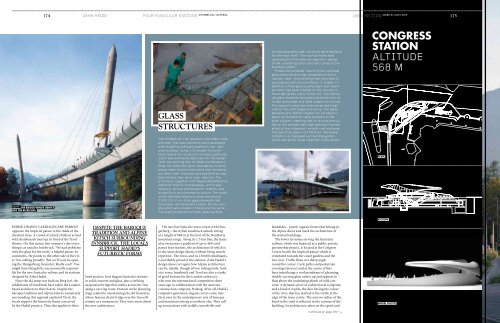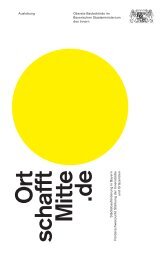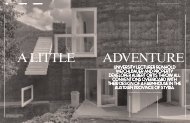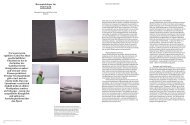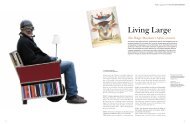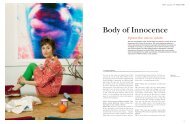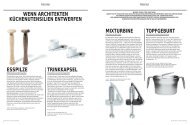Zaha Hadid's Four Alpine Funicular Stations In ... - SandraHofmeister
Zaha Hadid's Four Alpine Funicular Stations In ... - SandraHofmeister
Zaha Hadid's Four Alpine Funicular Stations In ... - SandraHofmeister
Create successful ePaper yourself
Turn your PDF publications into a flip-book with our unique Google optimized e-Paper software.
above the bridge winds gently,<br />
like the river inn.<br />
<strong>In</strong>nsbruck / AustrIA<br />
174 <strong>Zaha</strong> hadid <strong>Four</strong> <strong>Funicular</strong> stations<br />
Horse-drawn carriages are parked<br />
opposite the imperial palace in the shade of the<br />
chestnut trees. a crowd of school children armed<br />
with skateboards meet up in front of the Tyrol<br />
theatre. on this sunny, late-summer’s day everything<br />
is as usual in innsbruck. ‘we had problems<br />
with the glass for the roofs,’ a helpful passer-by<br />
comments. He points to the other side of the river<br />
inn, adding proudly: ‘But we’ll soon be opening<br />
the Hungerburg funicular. really cool!’ You<br />
might have thought he was personally responsible<br />
for the new funicular railway and its stations<br />
designed by <strong>Zaha</strong> Hadid.<br />
since the ski jump was built on Berg isel, the<br />
inhabitants of innsbruck have taken the Londonbased<br />
architects to their hearts. despite the<br />
baroque tradition and alpine kitsch consistently<br />
surrounding this regional capital of Tyrol, the<br />
locals support the futuristic forms conceived<br />
by the Hadid practice. That also applies to their<br />
Despite the baroque<br />
traDition anD alpine<br />
kitsch surrounDing<br />
innsbruck, the locals<br />
support haDiD’s<br />
futuristic forms<br />
latest project: four elegant funicular stations<br />
in solid concrete and glass, plus a striking<br />
suspension bridge that snakes across the inn<br />
along a curving route. protests at the planning<br />
stage related to maintaining the old funicular,<br />
whose famous chain bridge over the inn will<br />
remain as a monument. They were never about<br />
the new architecture.<br />
GlAss<br />
structures<br />
tHe formS of tHe double-Curving roofs<br />
and their individual elements were developed<br />
with modelling software applied in car- and<br />
boat-building. using 1:50 models the architects<br />
tested the results for surface continuity,<br />
which was extremely important for the design<br />
(with the working title of ‘Shell and Shadow’).<br />
when the materials were considered, mineralbased<br />
material and metal were also reviewed,<br />
but after their reactions and possibilities had<br />
been tested, they were soon rejected. the<br />
architects, together with pagels metalltechnik,<br />
opted for thermo-formed glass, which was<br />
tested in various processes for stability and<br />
durability in an overhead structure. the roofs<br />
of the individual stations comprise around<br />
2,000 10-12-cm-thick glass elements that<br />
have been varnished and coated. no two panels<br />
(which were made in China) are the same.<br />
the exact production of each glass surface,<br />
The new line links the town centre with Hungerburg<br />
– the stylish innsbruck suburb sitting<br />
at a height of 868 m at the foot of the nordkette<br />
mountain range. along its 1.7-km line, the funicular<br />
overcomes a gradient of up to 46% and<br />
passes four stations, the architecture of which is<br />
in the same design idiom, without being merely<br />
repetitive. The town, and its 130,000 inhabitants,<br />
is justifiably proud of the stations: <strong>Zaha</strong> Hadid’s<br />
design shows yet again how alpine architecture<br />
can be, ideally, though all too infrequently. and,<br />
vice versa: innsbruck and Tyrol are also a stroke<br />
of good fortune for the London architects,<br />
who won the international competition three<br />
years ago in collaboration with the austrian<br />
construction company, strabag. after all, Hadid’s<br />
computer-generated, elegant curves come into<br />
their own in the contemporary mix of baroque<br />
and mountain setting as nowhere else. They call<br />
up associations with icefalls, snowdrifts and<br />
its measurements and curvature were decisive<br />
for the roof ‘shell’. the roof surfaces that<br />
came about in this way correspond in design<br />
to the undulating solid-concrete curves of the<br />
building’s plinth.<br />
production entailed inserting the individual<br />
glass elements at a high temperature into a<br />
‘plaster-cast’, thus forming them precisely in<br />
accordance with the architects’ 3-d data. in<br />
addition, a float glass counterpart was inserted<br />
which had been treated on the reverse in<br />
the bright green colour of the inn. the individual<br />
glass elements have been attached with no<br />
visible anchorage to a steel support structure.<br />
the support comprises transverse and longitudinal<br />
ribs with diagonal bracing. the glass<br />
elements are neither clipped nor screwed in<br />
place, but bonded on metal brackets in the<br />
steel support, meaning that no mounts are visible<br />
on the outside that might detract from the<br />
effect of the iridescent, smooth roof surfaces.<br />
the top of the glass roof fits flush. rainwater<br />
collects in a concealed surrounding gutter,<br />
which serves for snow retention in the winter.<br />
landslides – purely organic forms that belong in<br />
the alpine décor and mark the architecture of<br />
the station buildings.<br />
The lower terminus serving the funicular<br />
railway, which was financed as a public-private<br />
partnership project, is located at the congress<br />
centre beside the imperial palace which is<br />
orientated towards the court gardens and the<br />
inn river. Traffic flows at a sharp angle<br />
round the corner. cycle paths and pedestrian<br />
crossings intersect and at the centre of this<br />
busy interchange a roof membrane of gleaming,<br />
double-curving glass arches up and appears to<br />
float above the undulating plinth of solid concrete.<br />
a dynamic piece of architectural sculpture,<br />
and a kind of reptile, the skin having the colour<br />
of the river, that has nestled in the traffic at the<br />
edge of the town centre. The narrow radius of the<br />
bend in the road is reflected in the contour of the<br />
building. its architecture takes on the speed and<br />
Continued on page 180∫<br />
long section mArk #11/2007-2008 175<br />
congress<br />
station<br />
altitude<br />
568 m<br />
Plan.<br />
section.<br />
model Photo.


